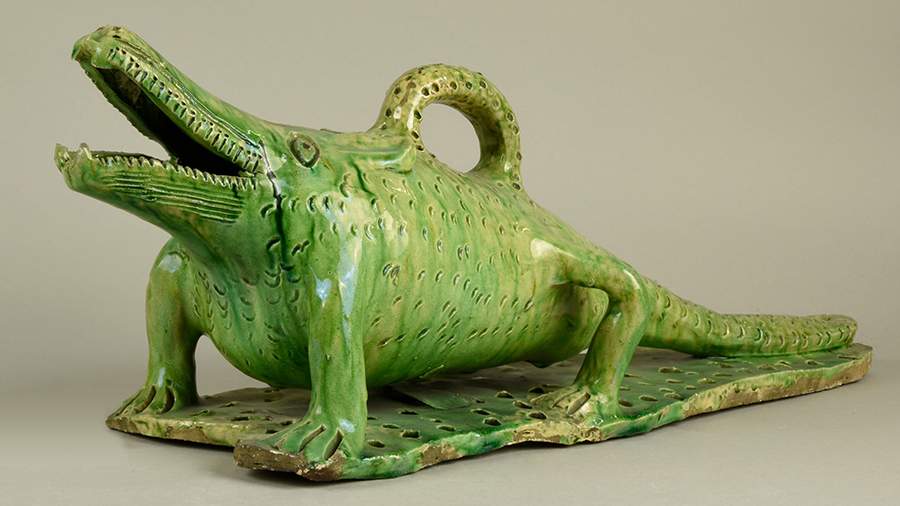Historical Museum opens the exhibition "Fabulous images in Russian ceramics"

The famous Ryazan ceramics will be presented as part of the "Your Country" project, dedicated to the cultural heritage of the regions of Russia.
The Historical Museum is opening an exhibition "Fabulous images in Russian ceramics", which presents the works of the famous Ryazan ceramic production in the city of Skopin. More than 80 works of ancient crafts from the Ryazan province will be presented for the first time to a wide audience.
The production of pottery in the city of Skopin until the middle of the 19th century was limited to dishes - pots, crates, bowls. In the 1860s, a unique center of artistic ceramics appeared here, which existed until 1917. Local ceramicists, competing with each other in sculpting skills, made unusual sculptural vessels covered with yellow, brown and green glazes. The works of art from this region, with their complex fantastic shapes and distinctive compositional solutions, have attracted the attention of many connoisseurs and collectors. Thanks to patrons, Skopin's figurative vessels have become an important part of museum collections. The State Historical Museum has the largest collection of Skopin ceramics from the 19th century in the country.
"The Historical Museum, thanks to the diversity and scale of its collections, has an exceptional opportunity to acquaint Muscovites and guests of the capital with the richest cultural heritage of the regions of Russia. The unique images embodied in the works of pottery by talented Ryazan craftsmen are a vivid example of how diverse and original folk art is. I think that such projects not only contribute to the preservation of various folk crafts with their centuries-old artistic and technological traditions, but also inspire modern craftsmen to create new masterpieces," says Alexey Levykin, General Director of the Historical Museum.
The decorative figurative vessels of the Skopin potters are a vivid example of how a folk craftsman perceives and unites the real world and the fantasy world, which connects all these objects with the world of fairy tales. The keramists of Skopin drew their inspiration from folk tales and folklore, they transferred their favorite images into plastic forms of jugs, candlesticks and sculptures, where fairy-tale characters (Polkan, Dragon, Sirin) coexist with animals and people. In some cases, one vessel unites several characters, and such works can be read as a fairy tale or poetic narrative close to the literary genre.
The collection of the Historical Museum includes numerous artistic monuments made by the best craftsmen – part of this priceless collection will be presented for the first time in the Chairman's Office in the Main Building of the Historical Museum. The exhibition consists of three sections.
The first hall tells about the origins of figurative thinking, about graphic and artistic sources that inspired potters to create decorative figurative vessels. Here, visitors will see handwritten books from the 7th century and folk paintings (lubok) from the middle of the 19th century. This neighborhood allows us to show the transformation of a heroic epic into a fairy tale.
This hall will feature two tiled panels with images of animals and birds with original inscriptions such as "Here I am fluttering, picking berries", "I dance the bear, but I won't tell the dog", "I run where I bought in Yaroslavl", "The Autocrat is a lion". A separate complex will consist of tiles depicting a king, a knight and a farmer, painted according to Western European engravings.
The second hall will feature the famous figurative vessels and sculptures of the city of Skopin: "The Osprey and the Eagle are the symbol of Ryazan ceramics", "The Lion is the king of animals", "The double–headed eagle is the royal bird", "The Bear is the master of Ryazan forests", "Polkan is the beloved epic hero", "Man is the center of the world", "Pets and birds – reading the world around them", "Exotic animals and birds are a reflection of the world of the unknown, the unknown.
An interactive zone will be organized at the exhibition, where young museum visitors will be able to try themselves as artists.
The exhibition is complemented by painted tiles from the 18th century with images of animals and people. Furnace ceramics of the XVIII century has a developed figurative language based, among other things, on folk folklore. The comparison of the two types of ceramic art will make it possible to trace the continuity of mythological and imaginative thinking in folk art.
Press screening: March 25, 2025 at 3 p.m.
Переведено сервисом «Яндекс Переводчик»
